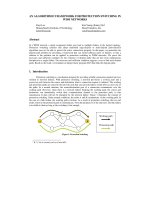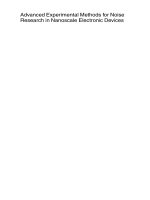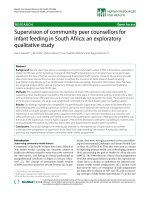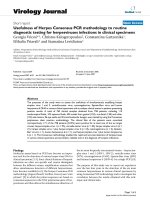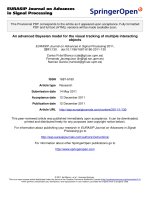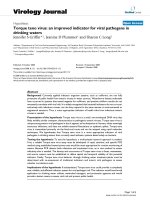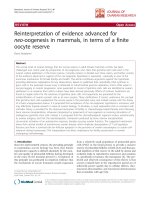An advanced methodology for windscreen modelling in ls dyna
Bạn đang xem bản rút gọn của tài liệu. Xem và tải ngay bản đầy đủ của tài liệu tại đây (621.98 KB, 10 trang )
International Journal of Mechanical Engineering and Technology (IJMET)
Volume 10, Issue 12, December 2019, pp. 380-389, Article ID: IJMET_10_12_040
Available online at />ISSN Print: 0976-6340 and ISSN Online: 0976-6359
© IAEME Publication
AN ADVANCED METHODOLOGY FOR
WINDSCREEN MODELLING IN LS DYNA
Amol Jaware
Applus IDIADA Automotive Technologies India Pvt. Ltd., India
Sudip Chandratre
Applus IDIADA Automotive Technologies India Pvt. Ltd., India
Mario Perez
Applus IDIADA Automotive Technologies Spain.
Jayadip Narule
Applus IDIADA Automotive Technologies India Pvt. Ltd., India
ABSTRACT
Laminated Safety Glass (Glass/PVB/Glass) is widely used for the automobile
windscreens. Poly vinyl butaryl (PVB) placed in between two glass layers constructs
the laminated glass. The very purpose of using the interlayer is to avoid separation of
glass pieces after breakage and thereby reduce the possibility of injury to occupant
and pedestrians.
The stiffness of the windscreen plays vital role in roof crush, frontal impact and
pedestrian load cases. Pedestrian load cases are inherent part of the EURO NCAP,
KNCAP and JNCAP. Head Injury Criteria (HIC) value decides the rating of
pedestrian load case. To perform head impact tests on windscreen is tedious task since
it involves the replacement of the whole windscreen for each impact point. To avoid
this and for the purpose of cost saving it is very important to develop the reliable
windscreen failure methodology in CAE, to model the behavior of windscreens after
impact.
The present study is carried out on Ls-Dyna solver for pedestrian head impact on
windscreen. Methodology for correlation of acceleration pulse is developed by using
the material cards in Ls-Dyna. This new material card has the capability to handle
tension and compression strengths differently. The propagation of crack in glass
layers can be visualized and hence the crack pattern of the glass can be predicted.
Glass laminates fails when the stress exceeds the maximum principle normal stress.
The crack pattern in the region of impact becomes visible once the energy criteria is
reached. PVB interlayer continues to provide stiffness after the impact. Head-form
impacts are simulated at four locations of the windscreen and results are validated
with test. The correlation activity is performed by monitoring the HIC values, pulse
trend and crack pattern. Similar trend of acceleration pulse is obtained with the good
agreement of first and second peaks with test.
/>
380
An Advanced Methodology for Windscreen Modelling in Ls Dyna
Abbreviations
EURO NCAP
KNCAP
JNCAP
CAE
BIW
The European New Car Assessment Program
Korean New Car Assessment Program
Japan New Car Assessment Program
Computer Aided Engineering
Body in White
Keywords: Laminated safety Glass, LS-Dyna, HIC.
Cite this Article: Laura A. Beltrán, Oscar F. Avilés S, Mauricio Mauledoux, Oswaldo
Rivera, Robinson Jiménez, Prototype of a Human Upper Limb Driven by Pneumatic
Muscles. International Journal of Mechanical Engineering and Technology 10(12),
2019, pp. 380-389.
/>
1. INTRODUCTION
Modelling the failure behavior of windscreen is still under development. Many attempts have
been made till the date to establish the methodology, which would help in predicting the
failure behavior of windscreen. The study of single layer shell model to three layered
laminated glass model is available in literature. Out of two, three layered laminated glass
model is found to give promising results in comparison of single layer model. Three layered
laminated glass model has the two layers of glass and PVB layer is sandwiched in between.
The layers of glass are generally modelled with shell elements where as PVB can be modelled
with shell or solid elements. Laminated glass fracture shows very complex nature during the
impact. Laminate experiences the bending load condition at point of impact. The glass layer
on opposite side undergoes the tension and glass layer on same side of impact experiences
compression [1,2]. The initial behavior after impact is almost linear elastic and no fracture can
be observed. The glass layer on opposite side of impact breaks first, since glass being brittle
material is weak in tension. The crack formation takes place and it propagates to edge from
center of impact. Afterwards, the glass layer on same side of impact fails [1].
MAT_LAMINATED_GLASS,
MAT_JOHNSON_HOLMQUIST
and
MAT_MODIFIED_PIECEWISE_LINEAR_PLASTICITY are some most widely used
material cards for glass modelling in LS-Dyna. The detail capabilities of each of card is given
in table 1.
Table 1. Capabilities of material models.
Sr.
No.
1.
2.
3.
Mat
Laminated
Glass
Johnson
Holmquist
Ceramics
Piecewise
linear
plasticity
STRAIN
RATE
FAILURE
Anisotropy
thermal
DAMAGE
Y
Y
Y
Y
Y
/>
Tension/co
mpression
Element
SHELL
Y
SOLID
SHELL,
SOLID
381
Amol Jaware, Sudip Chandratre, Mario Perez, Jayadip Narule
The complex asymmetric behavior of laminated glass during fracture, demands the
provision of giving the tensile strength and compressive strength separately. The material
cards mentioned above does not have this capability [3]. In addition, anisotropy of glass can’t
be modeled with this existing materials. The newly released material card has these
capabilities.
In the present paper, methodology has been developed to model the glass by using LS
Dyna material card. This card has the advanced capabilities like provision to give separate
tensile and compressive strengths and ability to model the damage behavior. It is a smeared
fix crack model with different stress dependent failure criteria like Rankine, Mohr-Coulomb
or Drucker-Prager. According to Rankine’s criteria, tensile strength
and compressive
strength
of material bounds the major principle stress
and minor principle stress
as
follows
*
+
(1)
Mohr-Coulomb criteria has the four different cases of failure according to the state of
major principle stresses, either tensile or compressive.
(
)
(
(2)
)
1
(3)
(4)
(5)
Drucker-Prager criteria is given as follows
*(
)(
)
(
)√
+
(6)
Once the critical stress is reached in the element, two element degradation procedures are
available. One procedure allows the degradation of element in required number of load step
cycles(NCYCR), another uses the damage model. This damage model reduces the stress and
stiffness of the element. Flag is provided to choose between the available damage models.
MAT_ADD_EROSION card can be used with some of the above mentioned cards to
predict the crack pattern of windscreen. This material card is intended to predict failure
mainly for laminated glass impact. The parameters viz. critical stress, critical energy and
critical radius are need to specify for laminated glass discretized with shell mesh. Pyttel has
suggested a promising failure approach by using MAT_ADD_EROSION card parameters viz.
critical stress, critical energy and critical radius. According to this approach element deletion
takes place when the main failure criteria is reached in certain boundary region, along with
necessary condition of critical energy. The main failure criterion is defined by principle stress
value at failure. Once the main failure criterion is reached, that element is taken as center of
impact and circular boundary region is set around that element with radius equal to critical
radius. The internal energy of shells is then tested in circular boundary region against the
product of critical energy and area factor.
(
(7)
)
Area at the denominator is considered two times, because we expect the two shell layers
of laminate glass as the case in real scenario. If this energy balance is achieved in the given
circular boundary, then and only then the elements are allowed to erode by main failure
criteria.
/>
382
An Advanced Methodology for Windscreen Modelling in Ls Dyna
MAT_MOONEY_RIVLIN_RUBBER,
MAT_OGDEN_RUBBER
and
MAT_SIMPLIFIED_RUBBER are the material cards available for modelling the behavior of
PVB. Hyper elastic rubber material card is used to model the PVB in current methodology,
because of its simplicity. In this card, PVB can be modeled by giving material constants,
force-displacement curve or Nominal Stress-Nominal strain curve [3].
2. EXPERIMENTS
Dynamic head form impact tests are carried out on laminated windscreen at four different
locations. Adult head form impactor with the mass of 4.5 kg, angle of impact 65 deg. and
velocity of impact 11.129 m/s is used. The glass layers of used windscreen are 1.65 mm thick
and PVB layer is 0.7 mm thick. The positions of all the impact points are shown in fig 1. All
the impacts are carried out in convex direction of windscreen. The tests are conducted with
actual test environment by fixing the windscreen on BIW. The results of the test pulse for all
positions are shown in fig 2. As shown in the Acceleration plots of different positions two
peaks can be Clearly observed. If you observe the plot b in the fig2, the multiple curves at the
before failure stage are due to the presence of wiper in impact zone. The magnitude of the
first peak is dependent on the initial stiffness of windscreen, more the stiffness before failure
more is magnitude of first peak. The stiffness of PVB layer contributes majorly to magnitude
of second peak. The crack patterns of all impact positions are shown in fig 3. It can be
observed that crack patterns of position I and position II are spread on large area where as the
crack pattern of position III and position IV are local.
a) Position I
b) Position II
c) Position III
d) Position IV
Figure 1. Impact Positions
/>
383
Amol Jaware, Sudip Chandratre, Mario Perez, Jayadip Narule
3. DISCRETIZATION AND CONSTITUTIVE RELATION
a) Position I b) Position II c) Position III d) Position IV
Figure 2. Test acceleration curves for different impact positions
The CAE model is generated with reference to the actual test conditions. The chosen
discretization has the three layers of shell mesh, with element size of 10mm. The contact
between PVB and two glass layers is set to Tied contact. The PVB interlayer is tied to frame
with NRB connections. Glass layers of laminate are modelled with mat glass. The behavior
of glass before failure is isotropic defined by small strain linear elasticity with modulus of
elasticity E and Poisons ratio µ. A catastrophic asymmetric behavior occurs when the plain
Stress condition set by Rankine’s criteria is reached, where major principle stress
and
minor principle stress
are bounded by the tensile and compressive strength .
(
)
As soon as stress reaches the critical stress value given by the Rankine criteria, the crack
occurs in the direction perpendicular to the normal stress direction. The appearance of crack
sets up the crack co-ordinate system with respect to element coordinate system. The erosion
of elements within predefined radius will start when the main erosion criteria set by “sigma1”
and energy threshold set by “critical energy” will reach. This erosion of elements makes the
crack pattern visible [5].
/>
384
An Advanced Methodology for Windscreen Modelling in Ls Dyna
PVB interlayer is modelled with Hyper elastic rubber material card [6]. The strain energy
function used by this material card is defined as:
(
)
∑
(
) (
)
( )
(8)
Where
The material properties of glass and PVB interlayer are given in below table 2.
Table 2. Material properties of glass and PVB
Material
Glass
PVB
Parameter
Young’s Modulus
Density
Poison’s Ratio
Tensile Strength (Ft)
Compressive Strength (Fc)
Density
Poison’s Ratio
Value
70 GPa
2.5E-06 Kg/mm3
0.225
0.350 GPa
2 GPa
1.19E-06 Kg/mm3
0.495
4. RESULTS AND VALIDATION
Non-local failure criteria with element erosion technique is used in current methodology. A
non-local failure is induced in the windscreen with the help of three parameters critical
internal energy, critical radius and critical stress. Glass is modelled as linear elastic material
with MAT_ADD_EROSION and PVB is modelled as hyper elastic material. Stress based
/>
385
Amol Jaware, Sudip Chandratre, Mario Perez, Jayadip Narule
failure criteria is used in current model by applying Rankine theory of failure. The strength
values of the glass in tension and compression are assigned and different levels of non-local
parameters are considered. Initially the parameters in hyper elastic cards are assigned constant
values and sensitivity of non-local parameters on peaks of acceleration pulse are analyzed.
Afterwards, the sensitivity of PVB card parameters are analyzed for decided sets of non-local
parameters.
It is found that the first peak in acceleration pulse is highly affected by the glass material
parameters compared to PVB parameters. This is because they add the stiffness to the model
before failure of glass. It is observed that first peak increases with increase in values of critical
internal energy of element deletion, tensile strength of glass material and decrease in critical
radius of element erosion zone. Slight increase in first peak is also observed for increase in
PVB parameters. Second peak in Acceleration pulse is governed by the PVB material
constants. It increases with increase in constant values. The figure given below gives the
summary of sensitivity analysis.
Figure 4. Summary of sensitivity analysis
The results of acceleration pulse and crack pattern are given in following figures fig 5 and
fig 6 respectively. As seen from the figure good level of correlation has achieved with the
proposed methodology. The behavior of laminated glass before failure has obtained correctly
at all the impact locations. Card parameters viz. critical energy, critical radius and tensile
strength are tuned to achieve the good correlation in before failure zone. The after failure
behavior is also in good agreement, trend wise. Control on pulse is less in after failure zone.
The fracture pattern obtained is close to reality behavior at all points of impact. Material
property values are kept constant at each location of impact while the non-local parameters
need retuning to catch the peaks of the pulse. The curvature of glass, presence of hard points
and impact location controls the non-local parameter values. In addition, presence of micro
flaws in actually tested laminated glass at surface and edges, which are not modeled in CAE,
changes the stiffness at that location. In actual case, Laminated glass may fail below the
defined failure strength because of this micro flaws.
/>
386
An Advanced Methodology for Windscreen Modelling in Ls Dyna
a) Position I b) Position II c) Position III d) Position IV
Figure 5. Correlation Results at different impact positions (Use Colored Print)
a) Position I b) Position II c) Position III d) Position IV
Figure 6. Crack patterns at different impact positions
/>
387
Amol Jaware, Sudip Chandratre, Mario Perez, Jayadip Narule
The Head Injury Criteria values are calculated at the all impact positions and shown in
Fig.7 below. The HIC value of position II is in good agreement with the test curve HIC value.
HIC values at the other positions shows the considerable variation. This variation in HIC
values is obtained because of post breakage behavior of laminated glass.
Figure 7. Test and Simulation HIC values Comparison (Use Color Print)
5. CONCLUSIONS
In the current study, laminated glass (Glass + PVB + Glass) is modelled with mat glass and
hyper elastic material cards for glass layer and PVB interlayer respectively.
MAT_ADD_EROSON card is used with glass material card to predict the crack propagation.
Stress based failure criteria is implemented for glass with Rankine theory. Initially, the
priority is given for matching HIC values and later the trend of acceleration pulse with test
curve and crack pattern are given the attention.
Critical energy, Critical radius, Critical stress and Tensile strength of glass are observed to
play key role to achieve the initial stiffness of glass and hence the first peak of acceleration
pulse. These parameters are tuned carefully to achieve the first peak of pulse. PVB material
properties are responsible for second peak in acceleration pulse. The attempt is made to tune
the second peak, first by tuning the constants A & B and later by using the material curves for
range of strain rates. It is observed that fine tuning of the second peak is possible only after
the use of proper strain rate curve. Micro flaws present on the surface of laminated glass
makes its behavior different than CAE model of same. The brittle nature of glass and presence
of micro flaws on the surface and edges makes behavior of glass unpredictable. Non local
failure used for predicting crack pattern shows its dependence on curvature of glass and
location of impact. Therefore, a single material card cannot be released, which can predict
behavior at all impact points. The properties of glass and PVB are constant at each of impact
point, but non local parameter values needs tuning for each point.
REFERENCES
[1]
Christian Alter, Stefan Kolling, Jens Schneider: A New Failure Criteria For Laminated
Safety Glass.11th European LS-DYNA Conference 2017, Salzburg, Austria.
/>
388
An Advanced Methodology for Windscreen Modelling in Ls Dyna
[2]
M. Timmel, S. Kolling, P. Osterrieder, P.A. Du Bois: A finite element model for impact
simulation with laminated glass. International Journal of Impact Engineering 34 (2007)
1465–1478.
[3]
LS-Dyna Keyword User’s Manual, Volume-II, Livermore Software Technology
Corporation.
[4]
Qi Lui, Junyong Lui, Qiang Miao, Dazhi Wang, Xiaodong Tang: Simulation and Test
Validation of Windscreen Subject to Pedestrian Head Impact.
[5]
Frederic Nub, Andreas Herkenhoff, Lutz Eckstein: Effect of the Non local Failure Criteria
on the Acceleration Signal of Head Impactors at Impact in Windscreen Centre. LS-Dyna
Forum 2014.
[6]
Camilla Fors: Mechanical Properties of Interlayers in Laminated Glass Experimental and
Numerical Evaluation. ISRN LUTVDG/TVSM--14/5198--SE (1-52) | ISSN 0281-6679.
/>
389
